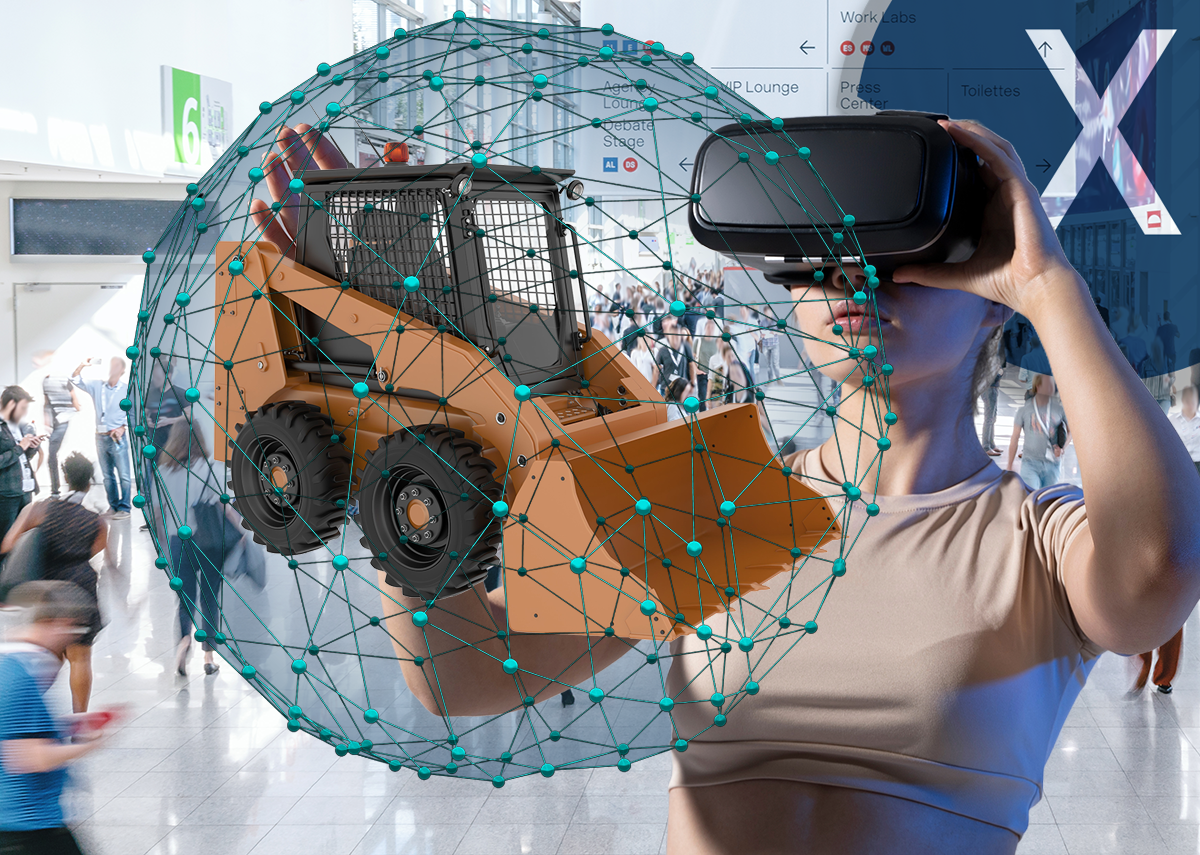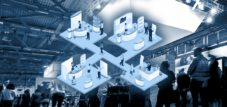
Hybrid trade fair with metaverse and physical trade fair, in-house exhibition or event – Image: Xpert.Digital
Hybrid trade fairs with and in the Metaverse: 3D product presentations are revolutionizing global events
The advantages of 3D product presentations in the Metaverse in combination with physical trade fairs and events, also used as a hybrid trade fair, are diverse and can help companies strengthen their presence in the market and create an impressive customer experience.
1. Expanded reach and global participation
By integrating 3D product presentations into the Metaverse, companies can digitally extend their physical trade shows and events. This allows them to reach a global audience that cannot be physically present. Participants from all over the world can attend the trade show virtually and interact with the products, leading to increased reach and brand awareness.
2. Cost effectiveness
Holding physical trade shows can be very expensive, including booth rental, staff travel and accommodation, and logistics. By integrating 3D product presentations into the Metaverse, companies can reduce these costs while still delivering a compelling trade show experience. Virtual booths can be created and customized cost-effectively, eliminating the need to transport physical products.
3. Interactive product presentations
In the Metaverse, products can be presented three-dimensionally and interactively. Visitors can view the products from all sides, zoom in, rotate, and see them in action. This immersive experience allows customers to develop a better understanding of the products and make informed purchasing decisions.
4. Real-time feedback and data analysis
While physical trade shows often make it difficult to capture accurate data on visitor behavior, 3D product presentations in the Metaverse offer detailed insights. Companies can track visitor behavior in real time, see which products attract the most attention, and gather valuable feedback. This data can then be used to inform future marketing and sales strategies.
5. Time flexibility and longer availability
While physical trade shows typically only last one or a few days, 3D product presentations in the Metaverse can be made available over a longer period. Customers have the flexibility to explore the booths and products at different times, increasing the chances of interaction and conversion rates.
6. Creative design options
In the Metaverse, there are virtually no limits to creativity. Companies can design virtual trade fair booths that are unique and impressive, with animations, special effects, and interactive elements. This allows them to stand out from competitors and offer an unforgettable trade fair experience.
7. Sustainability and environmental awareness
The integration of 3D product presentations in the metaverse also supports environmental awareness. By reducing physical materials and eliminating travel, companies can improve their environmental footprint and contribute to climate protection.
8. Collaboration and Networking
In the Metaverse, visitors can interact not only with products but also with each other. Virtual networking opportunities and chat functions allow customers to connect with companies, experts, and other participants and build business relationships.
9. Adapting to changing circumstances
Hybrid trade fairs, which combine physical and virtual components, offer companies the flexibility to adapt to changing circumstances. In the event of unforeseen circumstances such as natural disasters or pandemics, physical trade fairs may not be possible, but the digital component remains intact.
➡️ 3D product presentations in the Metaverse, combined with physical trade fairs and events, offer companies an innovative and promising way to make their products and services accessible to a broad audience and position themselves in an increasingly digital world. By combining technological advancements with personal interaction, companies can maximize their business potential and build customer relationships that extend beyond a single trade fair.
Our Industrial Metaverse configurator
Just try out our universally applicable (B2B/Business/Industrial) Metaverse configurator for all CAD / 3D demo options:
Xpert (B2B/Business/Industrial) Metaverse configurator for all CAD / 3D data can be used on all devices, one platform!
Suitable for:
Hybrid trade fair: trade fair event digital & real – the new trade fair marketing management for event managers
Trade fairs offer companies the ideal platform to present their products and services. No wonder, as exhibitors can optimally get in touch with their target group there and, ideally, achieve lucrative business deals. A trade fair stand, in turn, allows visitors to experience the products tactilely and to clarify any open questions in a personal conversation. But the potential of physical trade fairs can be increased even further by combining them with virtual elements. The resulting improvement in visitor experience and interaction options makes hybrid trade fairs an attractive alternative for more and more companies.
Marketing strategy hybrid trade fairs: The planning and organization of hybrid trade fairs 4.0 – Hybrid = Virtual & Reality
Hybrid trade fairs: Planning and organization of hybrid trade fairs (Virtual & Reality) – Image: Xpert.Digital
Trade shows are a traditional marketing strategy used by companies to showcase their latest products and connect with other businesses, customers, and potential partners within their industry. By participating in event marketing formats like trade shows, many companies aim to increase brand awareness and boost sales. Other common marketing objectives include fostering customer loyalty, improving product knowledge, and launching new products. Although trade shows and other in-person promotional events have faced stiff competition from digital marketing channels in recent years, they remain among the most profitable business-to-business (B2B) media strategies worldwide. In 2019, the global B2B trade show market was valued at US$34.4 billion, and this figure is expected to exceed US$40 billion by 2023.
More about it here:
Hybrid trade fairs & smart fairs/events: The type and execution of trade fairs are changing
The trade fair industry has been undergoing a transformation long before the COVID-19 pandemic. A growing number of companies are realizing that the financial investment often doesn't yield the desired results. This is hardly surprising, given the high setup and stand costs associated with exhibiting at a trade fair, while the staff present at the fair are working exclusively for the event for days or even weeks and are therefore unavailable for more lucrative projects. Furthermore, the impact on the event itself is limited and disappears once it's over.
More information here:
The trade fair of the future: The hybrid success model - Global events in the metaverse and on-site
Hybrid trade fairs and metaverse: The synergy for cross-border events
In recent years, the concept of trade fairs has continuously evolved to meet the changing needs and demands of the global business world. One of the most exciting developments in this area is the hybrid trade fair, which combines the best of both worlds – the physical, on-site presence and the digital world of the metaverse.
Hybrid trade fair with metaverse and physical exhibition: An innovative trade fair experience of the future
The metaverse is a virtual space detached from reality that allows people to move around in an immersive, 3D-like environment using avatars. This technology has gained enormous importance in recent years and is considered the future of the internet.
How does a hybrid trade fair with a metaverse and a physical trade fair work?
1. Virtual access to global target groups
Integrating a metaverse into a hybrid trade fair opens up the possibility for exhibitors and visitors to operate globally and across borders. Participants from all over the world can attend the fair without having to consider physical distance or travel restrictions. This means that companies can present their products and services to a much broader target audience, which greatly expands the potential for new business contacts and partnerships.
2. Immersive trade fair experience
The Metaverse enables a more immersive trade fair experience than traditional web conferencing platforms. Visitors can stroll through the exhibition halls with their avatars, visit virtual booths, view products in 3D, and interact with exhibitors. This creates an interactive and realistic experience that engages visitors more deeply with the trade fair and increases their attention span.
3. Flexibility and adaptability
A hybrid trade fair combining a metaverse and a physical exhibition offers exhibitors greater flexibility. Companies can choose whether they want to be present only in the virtual space, only on-site, or in both. This allows participants to tailor their trade fair participation to their individual needs and budgets. Additionally, content and presentations can be streamed in real time and later made available as on-demand content, giving interested parties from different time zones the opportunity to participate.
4. Cost effectiveness
Hybrid trade fairs can reduce costs compared to purely physical events. Companies save on travel and accommodation expenses for their employees, as many meetings and business contacts can take place virtually. At the same time, the virtual presence allows for the reuse of content and presentations for other events or marketing purposes.
5. Environmental friendliness
A hybrid trade fair also contributes to reducing the ecological footprint, as fewer physical resources and emissions are consumed through travel and logistics. This makes trade fair participation more environmentally friendly and demonstrates a company's commitment to sustainability.
6. Safety and Health
The combination of the physical trade fair and the Metaverse allows participants to experience the fair in a way that addresses their health and safety concerns. Particularly during health crises or unforeseen events that could restrict travel, the virtual component offers a suitable alternative for maintaining the fair's operation.
Outlook
The hybrid trade show, combining a metaverse and a physical exhibition, promises an exciting future for global, cross-border events. It offers companies the opportunity to expand their reach, create an immersive experience for attendees, and simultaneously reduce costs and operate more sustainably. The combination of physical and virtual presence opens up new possibilities and opportunities that can surpass traditional trade show experiences and usher the business world into an exciting new era.
Xpert.Digital – Pioneer Business Development
If you have any questions, further information or need advice on the topic of Consumer Metaverse or Metaverse in general, please feel free to contact me at any time.
I would be happy to serve as your personal advisor.
You can contact me by filling out the contact form below or simply call me on +49 89 89 674 804 (Munich) .
I'm looking forward to our joint project.
Xpert.Digital – Konrad Wolfenstein
Xpert.Digital is a hub for industry with a focus on digitalization, mechanical engineering, logistics/intralogistics and photovoltaics.
With our 360° business development solution, we support well-known companies from new business to after sales.
Market intelligence, smarketing, marketing automation, content development, PR, mail campaigns, personalized social media and lead nurturing are part of our digital tools.
You can find out more at: www.xpert.digital – www.xpert.solar – www.xpert.plus

